~ Welcome Home, A Virtual Tour of Our Church ~
You are standing on “Holy Ground”. This ground is holy, not only because it was blessed and dedicated during the pastorate of Father Gruender, but because it was built by “the work of human hands.”
From the local stone and handmade bricks, to the Ohio-made altars, from the original Reni paintings dating back to the 1600’s to the beautiful pipe organ, our house of worship stands as a witness of the dedication, commitment, and sacrifices made by so many. It is a testament to a deep faith that has been handed down through the generations. We are proud of both our church and museum. We hope you enjoy your visit in our community and will tell your friends about our parish.
Today, as you tour this beautiful church, we ask you to remember with us those who have gone before and sacrificed so much. Their faith inspires us. So, pause, sit, and meditate on one of our beautiful statues or paintings. Reflect before the Blessed Sacrament. Offer a prayer at the tomb of Father Helias, our founder. May the intercession of all who have gone before us assist us as we continue to build upon their strong foundation.
~ The Altar ~
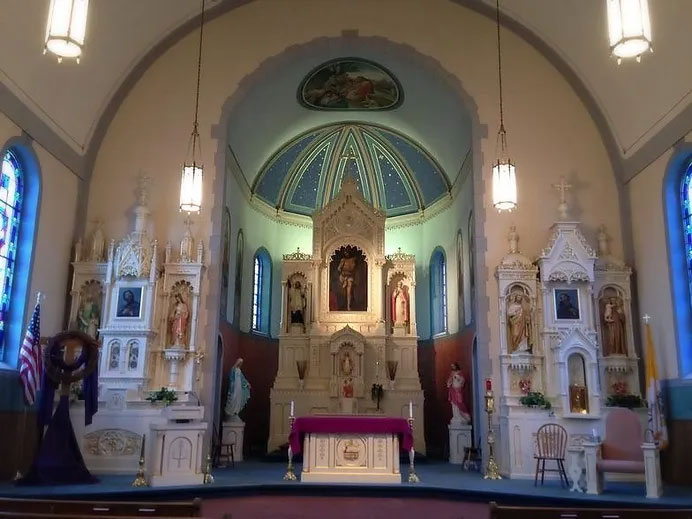
The central high altar was purchased in 1885 at a cost of $600. The side altars were added in 1904, when the small congregation could afford them. These cost $400 each. There were constructed by the young German orphans at the Josephinum in Columbus, Ohio, and shipped to our church on horse and wagon. This “orphanage” eventually evolved into a seminary, when some of the boys expressed a desire to become priests. This seminary is in operations to this day, and many priests serving this diocese were educated at what is today called, The Pontifical College Josephinum. This altar houses the parish collection of relics. These items displayed under glass are thought to be fragments of bones or objects once touched by the saints. While it maybe impossible to authentic these relics, they are a reminder of the holy men and women who traveled this faith journey before us.
~ Center Altar ~
St. Francis Xavier (Left Side)
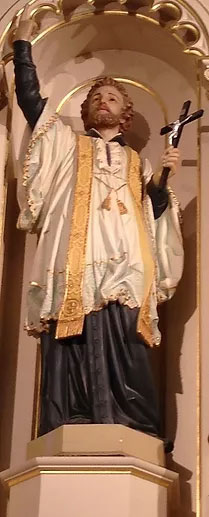
St. Francis Xavier is our parish patron. His feast day is December 3rd and he is the patron of foreign missions. St. Francis was born a Spaniard in 1506 in the City of Xavier. He attended the University of Paris. While a student, Francis met Ignatius of Loyola and along with six other men, they helped to found the Jesuit Order, of which Father Helias was a member. Francis spent his life teaching in India, Malaysia, and Japan. His dream was always to go to China. Francis Xavier’s dream of serving as a missionary in china was never realized because he died in route at the age of forty-six on an island only six miles from the China coast. He is alleged to have personally baptized several hundred thousand people. Often at day’s end, his arms ached from administering the sacrament. Pope Pius X, whose statue is on the right hand side of the altar, proclaimed Francis Xavier a saint and patron of all foreign missions.
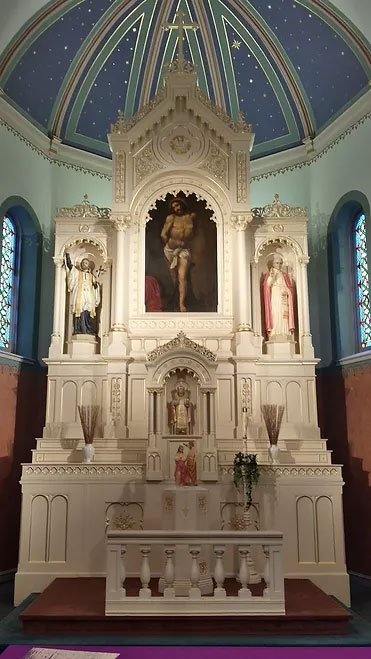
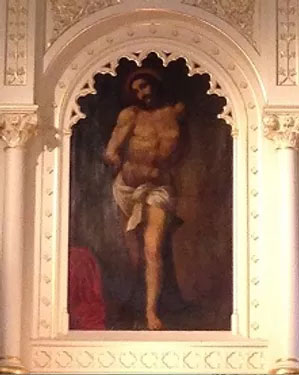
Pope Pius X (Right Side)
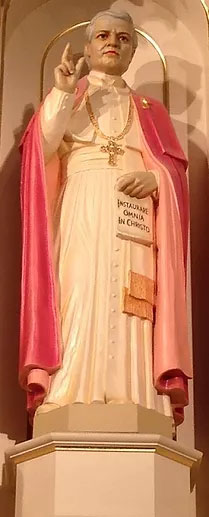
Pope Pius X was born in 1835 in Italy. He was educated there in the seminary and was ordained a priest in 1858. He systematically rose through the Roman Curia and was elected Pope on August 4, 1903. He immediately began to set into place a series of reforms. Most notably was that he lowered the age of first communion to around seven years old, and he encouraged routine readings of the scriptures. In fact, he set up a commission to revise the scriptures in order that they might be more easily read by the laity. Pope Pius X was canonized a saint in 1954, making him the most recent of saints whose images are located in the Church.
The oil paintings, housed in the three altars, are the work of the Italian Renaissance artist, Guido Reni (1575-1642). These three paintings are dated 1601. Both the Smithsonian and Vantican each have works by Reni in their collections. These paintings were a gift from Father Helias’ mother who was the Countess of Lens. The superior general of the Jesuit order brought them to this country from Europe in 1846. The central altar is adorned with a work entitled “The Flagellation”. On the left side altar is a painting of St. Francis Xavier, our parish patron. The right side altar house the painting of St. Francis of Assisi, one of the most beloved saints. We are proud to have these historic masterpieces restored and on permanent display in our church.
~ St. Francis Assisi Altar ~
Saint Anne (Left Side)
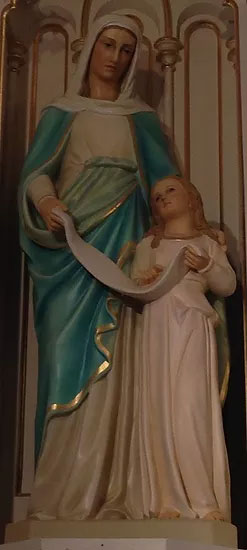
Saint Anne, seen here with her daughter Mary, was the wife of Joachim and the grandmother of Jesus. She is the patroness of housewives and grandmothers. Legend has it that Anne was married to Joachim when she was about twenty years old. Despite many attempts she was never able to conceive a child. It wasn’t until she was about forty, which was very old for her time, that she conceived the child, Mary. The conception took place after a day of prayer, An angel appeared to Anne and told her that, “She was to have a child, and that she must promise to dedicate this child to God.” Anne’s Feast day is July 26th.
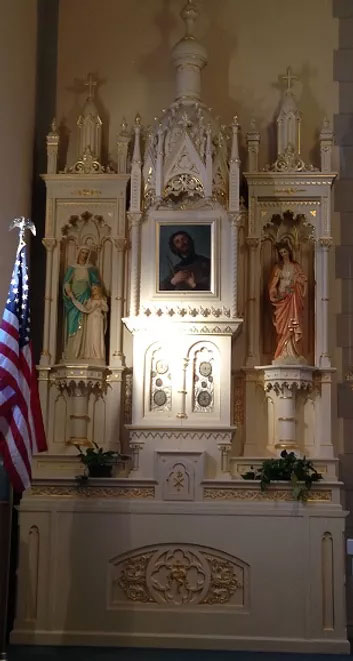
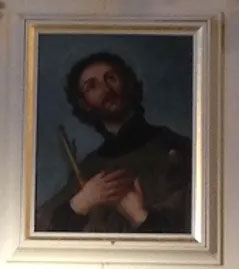
St. Francis of Assisi, the patron saint of animals and ecology, was a Roman Catholic saint who took the gospel literally by following all Jesus said and did.
Elizabeth of Hungary (Right Side)
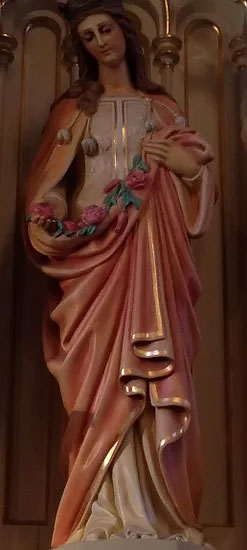
Saint Anne, seen here with her daughter Mary, was the wife of Joachim and the grandmother of Jesus. She is the patroness of housewives and grandmothers. Legend has it that Anne was married to Joachim when she was about twenty years old. Despite many attempts she was never able to conceive a child. It wasn’t until she was about forty, which was very old for her time, that she conceived the child, Mary. The conception took place after a day of prayer, An angel appeared to Anne and told her that, “She was to have a child, and that she must promise to dedicate this child to God.” Anne’s Feast day is July 26th.
~ St. Francis Xavier Altar ~
St. Joseph (Left Side)
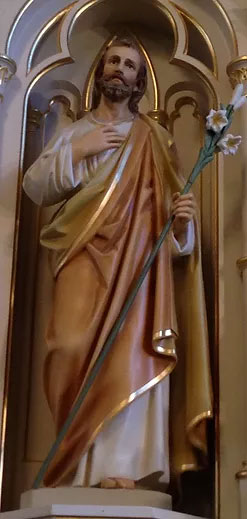
St. Joseph, husband of Mary, is the patron saint of carpenters, fathers, among other things house hunting. Very little is said in the scriptures about St. Joseph, except that he was the husband of Mary and a very skilled carpenter. St. Luke’s Gospel establishes that Joseph is a descendant of King David, which fulfills the prophecy that the Messiah is to come from the line of David. In the statue on our altar, Joseph is depicted holding a budding staff of lilies. The reason for this was that Zechariah, the high priest, told Mary that in a revelation, he was instructed by an angel to bring together all the single men and have them leave their staffs in the temple over night. The Lord’s choice of a husband for Mary would be revealed through a sign. The next morning, Joseph the carpenter’s staff was found blossomed; that was the sign for Mary to choose Joseph as her husband. St. Joseph’s Feast day is March 19th.
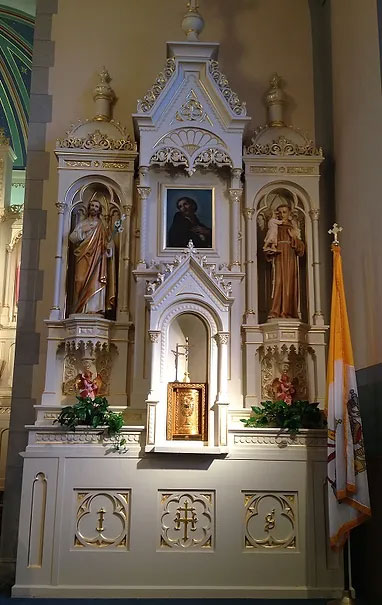
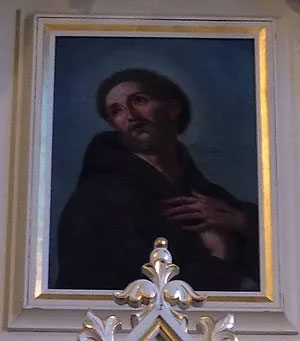
With encouragement from his friend Ignatius of Loyola, Xavier devoted himself to religious service and became one of the founders of the Jesuit order. Patron Saint of Japan and Missionaries.
St. Anthony of Padua (Right Side)
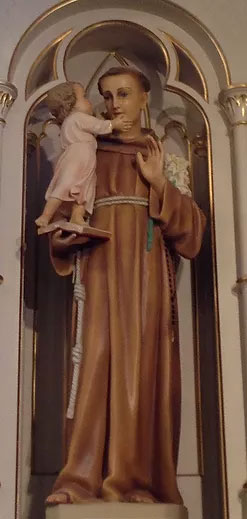
St. Anthony is most remembered as the patron saint of lost articles, but how this came to be is uncertain. One legend has it that one of his brother priests borrowed a book. When he failed to return it, the priest had a bad dream. It is probably from this legend that Anthony came to be know as the patron saint of lost items. Not only can he help to recover items that are lost, but he is also know to help people lose things that they would like to get rid of such as weight. Legend has it he was a short chubby man. A short rhyme or prayer associated with St. Anthony is “St. Anthony, St. Anthony come around. Something’s lost and can’t be found. Help me find my ________.” It is said that if this prayer is prayed three times, the lost item will be recovered. Anthony’s Feast day is June 13th.
The warm and evocative ceiling painting of Jesus and the children, as well as those of the four evangelists which are found on the side walls of the sanctuary, are all that is left from the original paint scheme of 1915. These paintings are on canvas and are bonded to the plaster. The artists are unknown. Itinerant artists who decorated churches for a living did much of this type of work. The ceiling painting was cleaned and restored by a former member of our parish.
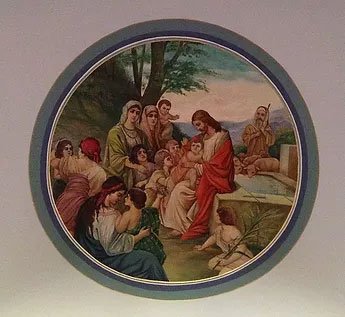
~ Sanctuary Paintings ~
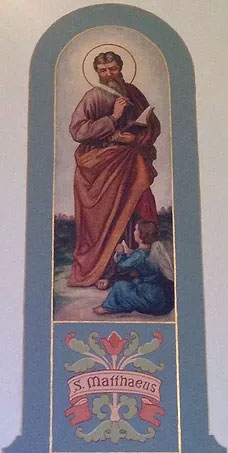
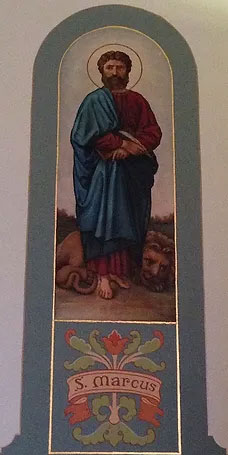
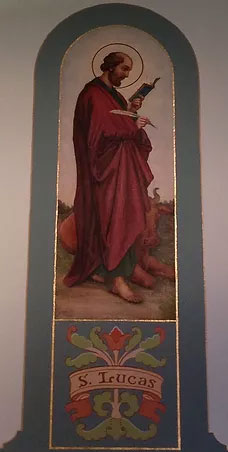
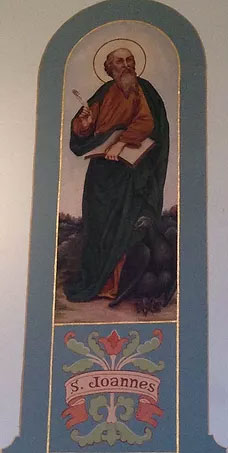
The evangelists: Matthew, Mark, Luke and John were cleaned. Along with the ceiling painting of Jesus, these were given a banding of color to frame the pictures and give them definition. The names, which appear in Latin under each saint, were part of the original decoration of the church. These had long ago been painted over. After carefully removing twenty layers of paint, these designs were discovered and recreated.
~ Stained Glass Windows ~

#1-Annunciation: The lower parts of the medallion show the fluer de lis, generally used as symbol of purity, representing here the Blessed Virgin. The upper part shows the dove, symbol of the Holy Ghost. “The Holy Spirit shall come upon Thee,” Luke 1:35.

#2-Visitation: “Mary arose and went to a town of Judea … entered the home of Zachary and saluted Elizabeth,” Luke 1:39-40. The medallion shows two flowers, symbolizing two flowers of mankind; in the upper part, the rose, represents the Blessed Virgin, in the lower part, the sunflower which stands for St. Elizabeth, Mother of John the Baptist, who later on shall prepare the way for Jesus, Ecce Agnus Dei “Behold the Lamb of God”.
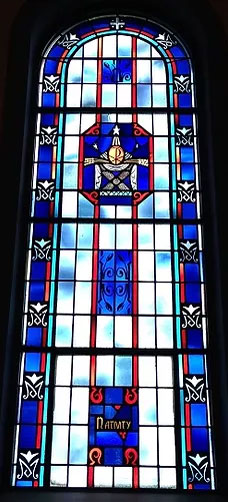
#3-Nativity: The crib and clothes indicate the humble conditions under which Our Lord was born in Bethlehem while the Chi-Rho and the crowns remind us that He is Christ, the Redeemer and King. In the upper part of the window you find the star of Bethlehem.
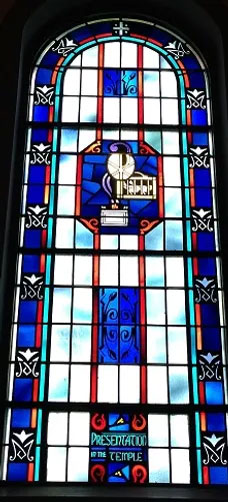
#4-Presentation: “They took Him up to Jerusalem to present Him to the Lord” and to “offer a pair of turtle doves or young doves,” Luke 2:22-23
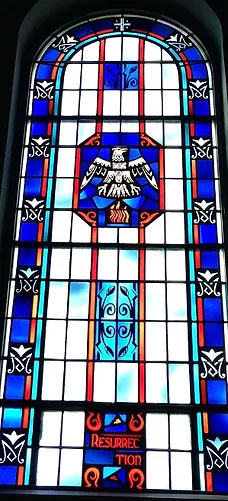
#5-Resurrection: The symbol of our Lord’s resurrection is the phoenix, a legendary bird, resembling an eagle and living to an age of four or five hundred years. It gathers a nest of sweet smelling twigs and spices which are set on fire by the heat of the sun and by the fanning of the bird’s wings. The phoenix is consumed in the fire; and out of the ashes the bird rises again, recreated and young.
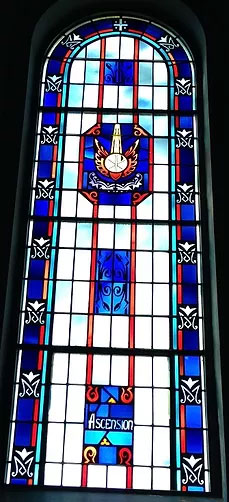
#6-Ascension: Shows the Chi-Rho (Christ) with wings ascending into heaven.
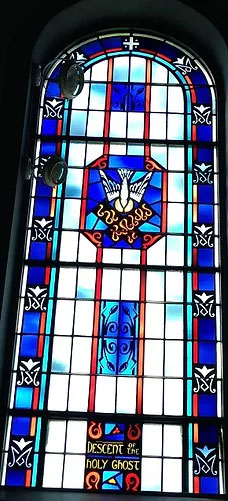
#7-Descent of Holy Ghost: As the Holy Ghost, represented by the Dove, descended upon the disciples, a tongue of fire (the flames) appeared on each of them and they were filled with the Holy Ghost.
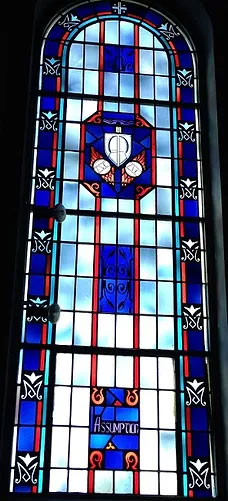
#8-Assumption: The center shows the monogram of the Blessed Virgin, AMR, the wings symbolize the Assumption itself. “Ave Maria.”
~ Shrine Areas ~
In 1976 a new Reconciliation Room was created in the space formerly used as a sacristy. This room is located to the right of the sanctuary. The former confessionals provided a natural space for shrines. On the right side of the church is the famous scene known as Pieta. This is a replica of the Michelangelo’s original, which is displayed in the Vatican. Our parish “Book of Prayers” is also located here. The prayers written here are remembered in each Mass offered in our parish. Opposite this area is another shrine which is home to the beautiful statues of Our Blessed Mother and the Sacred Heart of Jesus. Our Lady of Perpetual Help is also enshrined here. The kneeler provides a place of quiet reflection and prayer.
~ Use of Former Communion Rails ~
Our parish is proud to have been able to artfully and liturgically reincorporate into our church the two communion rails which once graced the entrance to our sanctuary. The first communion rail was made of wood and was curved to fit the curved steps. This rail was in place until the 1940’s. After World War II, Father Reker asked for donations from the “boys” who came home from the war. It was at this time the “new” rail made of brass and marble was purchased and installed. The original rail has been refashioned into prie dieux for the bride and groom. The presider’s chair is also fashioned from this rail. The bronze and marble rail has been installed in front of the grave of Father Helias, our founder. The two gates from this rail have also been refashioned into kneelers.
~ The 1998 Restoration – “Our Parish, Our Future” ~
What began as “just a simple paint job” for the interior of our church, grew into a major project of preserving our past in order to hand it on to our future generations. The parish hired a restoration consultant and began months of study. The structure was evaluated from the crawl space to the bell tower to insure integrity. The building was tuck pointed and waterproofed. Then the interior was addressed. We had to understand the original construction (steel tie rods and lack of ornamentation). We wanted to discover as much as we could about the building in its earliest days. Layers of paint were removed. Old photographs were studied. Early stencils were discovered.
Knowing we needed to work with the colors present in the windows, the committee was ready to follow architectural principles and contemporary liturgical guidelines. We identified a three-fold focus: restoration, preservation, and conservation. The wide-open expanse of wall and ceiling space needed to be “brought to scale.” This meant creating panels and adding dimension. The darker colors are placed low to the floor and the lighter colors rise from there. The most neutral colors are used in the largest spaces. The highlight or accent colors were drawn from the windows. Blue, teal, and terra cotta were used. When work was completed, twenty-five colors had been mixed to bring this project together. The stencil work you see in the church today had been lost and was reintroduced to the sanctuary and narthex (entries). The apse was painted to remind one of the stars of heaven. In the tradition of painting, the artists placed all the starts except one, the larger unique star that is placed on the eastern side of the dome. The is the “Morning Star” or Christ star. References can be found in the Advent readings, the Exultet at the Easter Vigil and in the book of Revelation. It has been tradition that the pastor places this star. That tradition was followed here in our church.
In addition to the historical painting, new carpet was added and the pews and kneelers were recovered. Sanctuary lighting was installed and a focal area was created in front of the altar to serve the needs of weddings and children’s liturgies.
